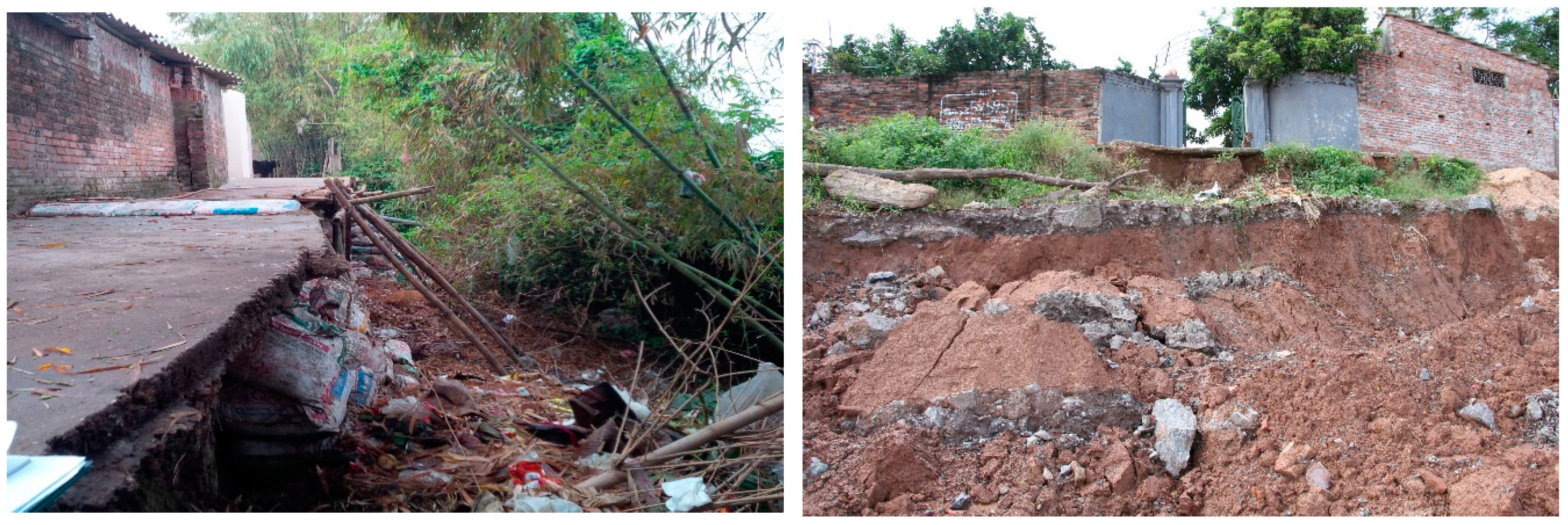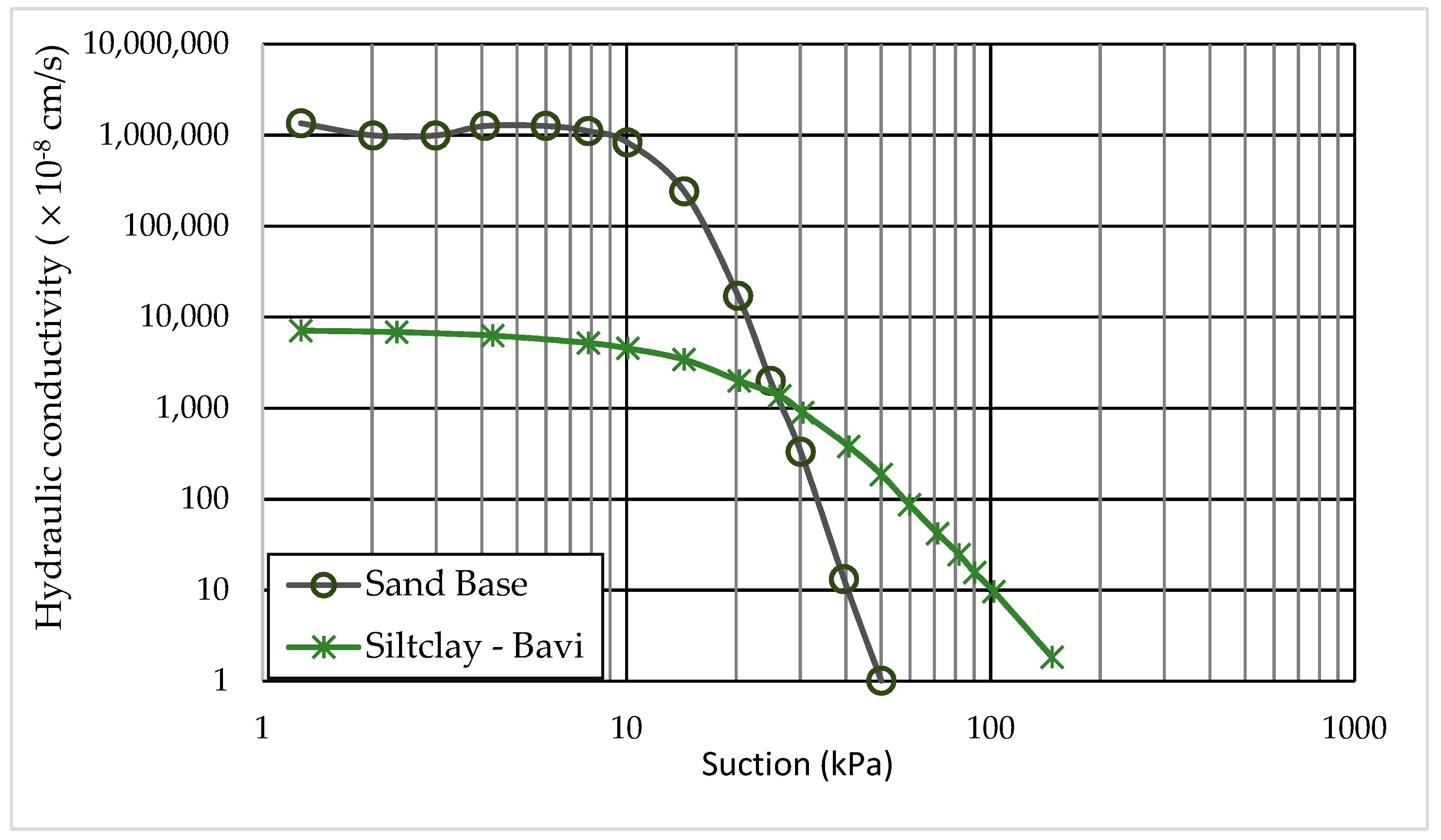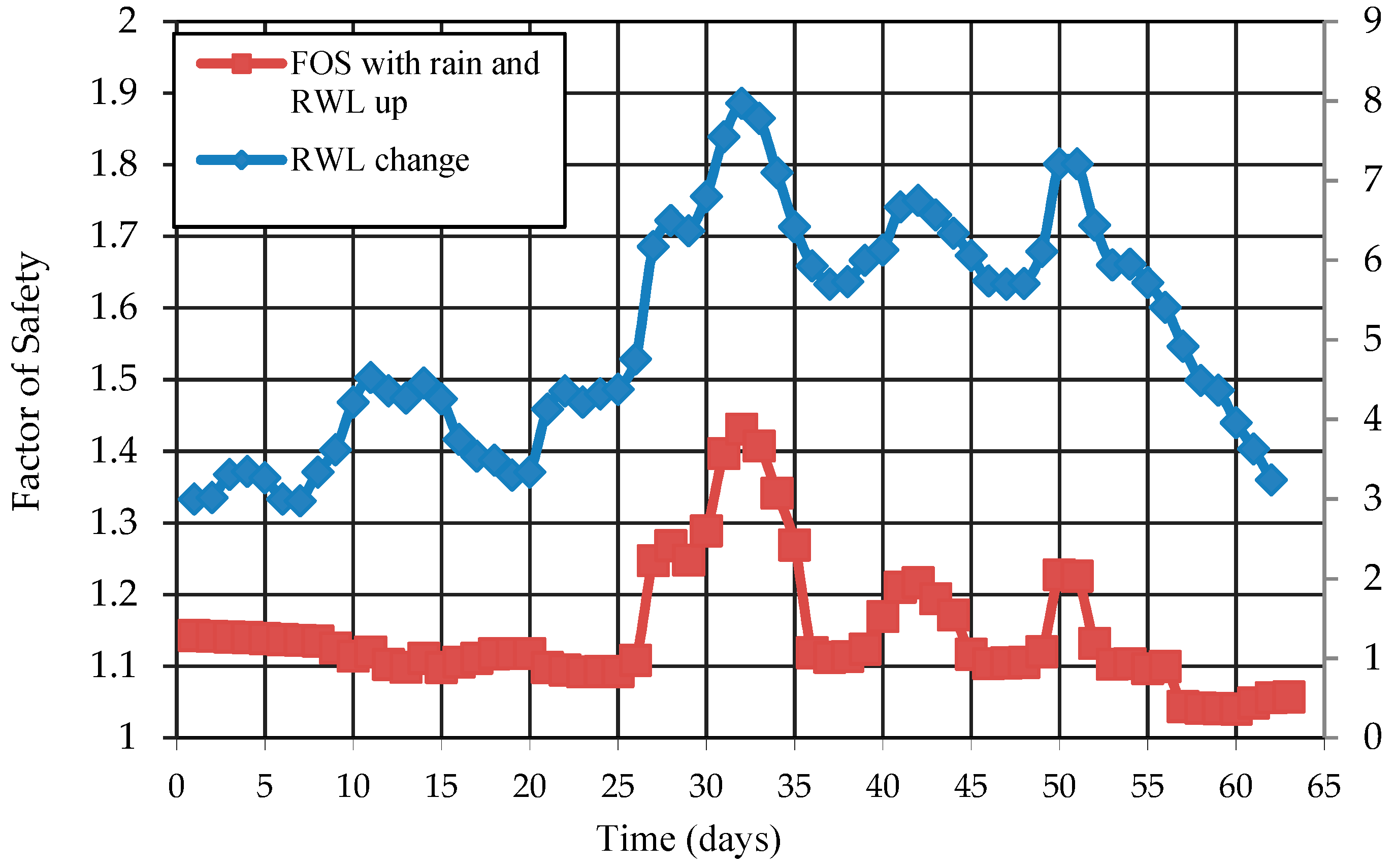Assessing the Effects of Rainfall Intensity and Hydraulic Conductivity on Riverbank Stability
Abstract
1. Introduction
2. Materials and Methods
2.1. Field Investigations and Soil Properties
2.2. Numerical Model Framework
2.2.1. Riverbank Geometry and Hydraulic Boundary Condition
2.2.2. Cases Used in Analysis
3. Results
3.1. Effects of the Initial Saturation Condition
3.2. Effects of Rainfall Intensity and Hydraulic Conductivity on Riverbank Stability
3.3. Effects of Rainfall Intensity and Hydraulic Conductivity on the Water Infiltration Mechanism
3.4. Effects of Rainfall Infiltration and River Water Level Fluctuation
4. Conclusions
Author Contributions
Funding
Acknowledgments
Conflicts of Interest
References
- Gasmo, J.; Rahardjo, H.; Leong, E.C. Infiltration effects on stability of a residual soil slope. Comput. Geotech. 2000, 26, 145–165. [Google Scholar] [CrossRef]
- Iverson, R.M. Landslide triggering by rain infiltration. Water Resour. Res. 2000, 36, 1897–1910. [Google Scholar] [CrossRef]
- Rahardjo, H.; Leong, E.C.; Rezaur, R.B. Studies of rainfall-induced slope failures. In Proceedings of the National Seminar, Slope 2002, Bandung, Indonesia, 27 April 2002; pp. 15–29. [Google Scholar]
- Rahardjo, H.; Ong, T.H.; Rezaur, R.B.; Leong, E.C. Factors controlling instability of homogeneous soil slopes under rainfall. J. Geotech. Geoenviron. Eng. 2007, 133, 1532–1543. [Google Scholar] [CrossRef]
- Kim, J.; Jeong, S.; Park, S.; Sharma, J. Influence of rainfall-induced wetting on the stability of slopes in weathered soils. Eng. Geol. 2004, 75, 251–262. [Google Scholar] [CrossRef]
- Lu, N.; Godt, J. Hillslope Hydrology and Stability; Cambridge University Press: New York, NY, USA, 2013. [Google Scholar]
- Gofar, N.; Lee, M.L.; Asof, M. Transient seepage and slope stability analysis for rainfall-induced landslide: A case study. Malays. J. Civ. Eng. 2006, 18, 1–13. [Google Scholar]
- Cai, F.; Ugai, K. Numerical analysis of rainfall effects on slope stability. Int. J. Geomech. 2004, 4, 69–78. [Google Scholar] [CrossRef]
- Huang, C.C.; Lo, C.L.; Jang, J.S.; Hwu, L.K. Internal soil moisture response to rainfall-induced slope failures and debris discharge. Eng. Geol. 2008, 101, 134–145. [Google Scholar] [CrossRef]
- Egeli, I.; Pulat, H.F. Mechanism and modelling of shallow soil slope stability during high intensity and short duration rainfall. Sci. Iran. 2011, 18, 1179–1187. [Google Scholar] [CrossRef]
- Suryo, E.A. Real-Time Prediction of Rainfall Induced Instability of Residual Soil Slopes Associated with Deep Cracks. Doctoral Thesis, School of Earth, Environment and Biological Science Science and Engineering Faculty Queensland University of Technology February, Brisbane, Australia, 2013. [Google Scholar]
- Yunusa, G.H.; Kassim, A.; Gofar, N. Effect of surface flux boundary conditions on transient suction distribution in homogeneous slope. Indian J. Sci. Technol. 2014, 7, 2064–2075. [Google Scholar]
- Oh, S.; Lu, N. Slope stability analysis under unsaturated conditions: Case studies of rainfall-induced failure of cut slopes. Eng. Geol. 2015, 184, 96–103. [Google Scholar] [CrossRef]
- Bordoni, M.; Meisina, C.; Valentino, R.; Lu, N.; Bittelli, M.; Chersich, S. Hydrological factors affecting rainfall-induced shallow landslides: From the field monitoring to a simplified slope stability analysis. Eng. Geol. 2015, 193, 19–37. [Google Scholar] [CrossRef]
- Ishaka, M.F.; Alib, N.; Kassimb, A.; Bahru, U.J. Analysis of suction distribution response to rainfall event and tree canopy. J. Teknol. 2016, 78, 83–87. [Google Scholar]
- Heyerdahl, H. Influence of extreme long-term rainfall and unsaturated soil properties on triggering of a landslide—A case study. Nat. Hazards Earth Syst. Sci. 2017. [Google Scholar] [CrossRef]
- Mahmood, K.; Kim, J.M.; Ashraf, M. The effect of soil type on matric suction and stability of unsaturated slope under uniform rainfall. Ksce J. Civ. Eng. 2016, 20, 1294–1299. [Google Scholar] [CrossRef]
- Yang, Y.; Wang, Y.; Wu, Y. The Influence of Rainfall on Soil Slope Stability. Electron. J. Geotech. Eng. 2015, 20, 13071–13080. [Google Scholar]
- Wu, L.; Zhou, Y.; Sun, P.; Shi, J.; Liu, G.; Bai, L. Laboratory characterization of rainfall-induced loess slope failure. Catena 2017, 150, 1–8. [Google Scholar] [CrossRef]
- Manenti, S.; Amicarelli, A.; Todeschini, S. WCSPH with limiting viscosity for modelling landslide hazard at the slopes of artificial reservoir. Water 2018, 10, 515. [Google Scholar] [CrossRef]
- Khalid, M.; Kim, J.M. Effect of hydraulic conductivity on suction profile and stability of cut-slope during low intensity rainfall. J. Korean Geotech. Soc. 2012, 28, 63–70. [Google Scholar] [CrossRef]
- Qi, S.; Vanapalli, S.K. Hydro-mechanical coupling effect on surficial layer stability of unsaturated expansive soil slopes. Comput. Geotech. 2015, 70, 68–82. [Google Scholar] [CrossRef]
- Wu, L.; Xu, Q.; Zhu, J. Incorporating hydro-mechanical coupling in an analysis of the effects of rainfall patterns on unsaturated soil slope stability. Arab. J. Geosci. 2017, 10, 386. [Google Scholar] [CrossRef]
- Zhang, G.R.; Qian, Y.J.; Wang, Z.C.; Zhao, B. Analysis of rainfall infiltration law in unsaturated soil slope. Sci. World J. 2014, 2014, 567250. [Google Scholar] [CrossRef]
- Rahimi, A.; Rahardjo, H.; Leong, E.C. Effect of hydraulic properties of soil on rainfall-induced slope failure. Eng. Geol. 2010, 114, 135–143. [Google Scholar] [CrossRef]
- Sasekaran, M. Impact of Permeability and Surface Cracks on Soil Slopes. Master’s Thesis, The University of Manchester, Manchester, UK, 2011. [Google Scholar]
- Gottardi, G.; Gragnano, C.G. On the role of partially saturated soil strength in the stability analysis of a river embankment under steady-state and transient seepage conditions. Presented at the E3S Web of Conferences. E3S Web of Conferences 9, Paris, France, 12–14 September 2016; Volume 19002. [Google Scholar] [CrossRef]
- Zhai, Q.; Rahardjo, H.; Satyanaga, A. Variability in unsaturated hydraulic properties of residual soil in Singapore. Eng. Geol. 2016, 209, 21–29. [Google Scholar] [CrossRef]
- Wu, L.Z.; Zhang, L.M.; Zhou, Y.; Li, B. Analysis of multi-phase coupled seepage and stability in anisotropic slopes under rainfall condition. Environ. Earth Sci. 2017, 76, 469. [Google Scholar] [CrossRef]
- Ojha, R.; Corradini, C.; Morbidelli, R.; Govindaraju, R.S. Effective saturated hydraulic conductivity for representing field-scale infiltration and surface soil moisture in heterogeneous unsaturated soils subjected to rainfall events. Water 2017, 9, 134. [Google Scholar] [CrossRef]
- Mahmood, K.; Ryu, J.H.; Kim, J.M. Effect of anisotropic conductivity on suction and reliability index of unsaturated slope exposed to uniform antecedent rainfall. Landslides 2013, 10, 15–22. [Google Scholar] [CrossRef]
- Yeh, H.F.; Wang, J.; Shen, K.L.; Lee, C.H. Rainfall characteristics for anisotropic conductivity of unsaturated soil slopes. Environ. Earth Sci. 2015, 73, 8669–8681. [Google Scholar] [CrossRef]
- Yeh, H.F.; Tsai, Y.J. Analyzing the Effect of Soil Hydraulic Conductivity Anisotropy on Slope Stability Using a Coupled Hydromechanical Framework. Water 2018, 10, 905. [Google Scholar] [CrossRef]
- Chen, P.; Mirus, B.; Lu, N.; Godt, J.W. Effect of hydraulic hysteresis on stability of infinite slopes under steady infiltration. J. Geotech. Geoenvironmental Eng. 2017, 143, 04017041. [Google Scholar] [CrossRef]
- Kim, J.; Hwang, W.; Kim, Y. Effects of hysteresis on hydro-mechanical behavior of unsaturated soil. Eng. Geol. 2018, 245, 1–9. [Google Scholar] [CrossRef]
- Zhang, J.; Li, J.; Lin, H. Models and influencing factors of the delay phenomenon for rainfall on slope stability. Eur. J. Environ. Civ. Eng. 2018, 22, 122–136. [Google Scholar] [CrossRef]
- Samadi, A.; Amiri-Tokaldany, E.; Darby, S.E. Identifying the effects of parameter uncertainty on the reliability of riverbank stability modeling. Geomorphology 2009, 106, 219–230. [Google Scholar] [CrossRef]
- Samadi, A.; Amiri-Tokaldany, E.; Davoudi, M.H.; Darby, S.E. Experimental and numerical investigation of the stability of overhanging riverbanks. Geomorphology 2013, 184, 1–19. [Google Scholar] [CrossRef]
- Fox, G.A.; Heeren, D.M.; Wilson, G.V.; Langendoen, E.J.; Fox, A.K.; Chu-Agor, M.L. Numerically predicting seepage gradient forces and erosion: Sensitivity to soil hydraulic properties. J. Hydrol. 2010, 389, 354–362. [Google Scholar] [CrossRef]
- Zhong-Min, Y.; Yan-Qiong, G. Coupling effect of seepage flow and river flow on bank failure. J. Hydrodyn. 2011, 23, 834–840. [Google Scholar]
- Yong, G.L.; Robert, E.; Thomas, Y.O.; Simon, A.; Blair, P.; Greimann, K.W. Modeling of multilayer cohesive bank erosion with a coupled bank stability and mobile-bed mode. Geomorphology 2014, 243, 116–129. [Google Scholar]
- Duong, T.T. Assessment of Riverbank Stability—The Perspectives of Unsaturated Soils and Erosion Function. Doctoral Dissertation, Ibaraki University, Mito, Japan, September 2014. [Google Scholar]
- Liang, C.; Jaksa, M.B.; Ostendorf, B.; Kuo, Y.L. Influence of river level fluctuations and climate on riverbank stability. Comput. Geotech. 2015, 63, 83–98. [Google Scholar] [CrossRef]
- Vanapalli, S.; Fredlund, D.; Pufahl, D.; Clifton, A. Model for the prediction of shear strength with respect to soil suction. Can. Geotech. J. 1996, 33, 379–392. [Google Scholar] [CrossRef]
- Van Genuchten, M.T. A closed-form equation for predicting the hydraulic conductivity of unsaturated soils 1. Soil Sci. Soc. Am. J. 1980, 44, 892–898. [Google Scholar] [CrossRef]
- GEO-SLOPE International Ltd. Seepage Modeling with SEEP/W. Available online: http://www.geo-slope.com (accessed on 2 January 2019).
- GEO-SLOPE International Ltd. Stability Modeling with SLOPE/W. Available online: http://www.geo-slope.com (accessed on 2 January 2019).
- Krahn, J. The 2001 RM Hardy Lecture: The limits of limit equilibrium analyses. Can. Geotech. J. 2003, 40, 643–660. [Google Scholar] [CrossRef]
- Aryal, K.P. Slope Stability Evaluations by Limit Equilibrium and Finite Element Methods. Doctoral Thesis, Norwegian University of Science and Technology, Trondheim, Norway, 2006. [Google Scholar]















| Riverbank Soil Properties | Silt-Riverbank Soil | Fine Sand Base | |
|---|---|---|---|
| Depth of layer | 10–1.5m | From 1.5 m to depth | |
| Grain size (%) | Coarse sand: 1–0.25 mm | 18.38 | |
| Fine sand: 0.25–0.075 mm | 13.46 | 80.91 | |
| Silt: 0.075–0.005 mm | 71.03 | 0.71 | |
| Clay < 0.005 mm | 15.51 | 0 | |
| Natural water content (%) | 18.5 | 4.72 | |
| Dry density (kN/m3) | 15.0 | ||
| Specific gravity | 2.62 | 2.68 | |
| Liquid limit (%) | 34.5 | ||
| Plastic limit (%) | 21 | ||
| Liquid index | 1.23 | ||
| Soil classification | ML | SP | |
| Saturated volume water content | 42 | 29 | |
| Air-entry value (kPa) | 20.05 | 9.3 | |
| Residual suction (kPa) | 90 | 25 | |
| Residual volumetric water content (%) | 10 | 4 | |
| a | 28.39 | 10.33 | |
| n | 4.205 | 18.89 | |
| m | 0.72 | 0.53 | |
| Max slope | 1.33 | 2.58 | |
| Hydraulic conductivity (cm/s) | 7.39 × 10−5 | 1.69 × 10−2 | |
| Cohesion force ((kPa) | 5.0 | 0 | |
| Internal friction angle (o) | 32 | 30 | |
| Saturated Degree (%) | Vol. Water Content (%) | Soil Suction (kPa) in Ba Vi | The Unsaturated Hydraulic Conductivity (HC, cm/s) Ba Vi | Name of Cases Versus HC | Name of Cases | The Ratio RI/HC at | ||||
|---|---|---|---|---|---|---|---|---|---|---|
| 10 mm/h | 30 mm/h | 50 mm/h | 10 mm/h | 30 mm/h | 50 mm/h | |||||
| 70 | 33 | 33 | 7 × 10−4 | H-1 | H-1-1 | H-1-2 | H-1-3 | 0.38 | 1.19 | 1.85 |
| 87 | 41 | 15 | 3 × 10−3 | H-2 | H-2-1 | H-2-2 | H-2-3 | 0.09 | 0.28 | 0.46 |
| 70 | 33 | 33 | 7 × 10−5 | M-1 | M-1-1 | M-1-2 | M-1-3 | 3.85 | 11.86 | 18.57 |
| 87 | 41 | 15 | 3 × 10−4 | M-2 | M-2-1 | M-2-2 | M-2-3 | 0.93 | 2.78 | 4.63 |
| 70 | 33 | 33 | 7 × 10−6 | L-1 | L-1-1 | L-1-2 | L-1-3 | |||
| 87 | 41 | 15 | 3 × 10−5 | L-2 | L-2-1 | L-2-2 | L-2-3 | 9.26 | 27.78 | 46.30 |
© 2019 by the authors. Licensee MDPI, Basel, Switzerland. This article is an open access article distributed under the terms and conditions of the Creative Commons Attribution (CC BY) license (http://creativecommons.org/licenses/by/4.0/).
Share and Cite
Duong, T.T.; Do, D.M.; Yasuhara, K. Assessing the Effects of Rainfall Intensity and Hydraulic Conductivity on Riverbank Stability. Water 2019, 11, 741. https://doi.org/10.3390/w11040741
Duong TT, Do DM, Yasuhara K. Assessing the Effects of Rainfall Intensity and Hydraulic Conductivity on Riverbank Stability. Water. 2019; 11(4):741. https://doi.org/10.3390/w11040741
Chicago/Turabian StyleDuong, Toan Thi, Duc Minh Do, and Kazuya Yasuhara. 2019. "Assessing the Effects of Rainfall Intensity and Hydraulic Conductivity on Riverbank Stability" Water 11, no. 4: 741. https://doi.org/10.3390/w11040741
APA StyleDuong, T. T., Do, D. M., & Yasuhara, K. (2019). Assessing the Effects of Rainfall Intensity and Hydraulic Conductivity on Riverbank Stability. Water, 11(4), 741. https://doi.org/10.3390/w11040741




